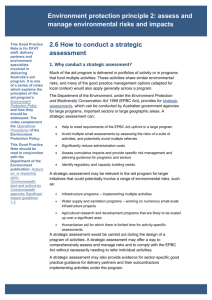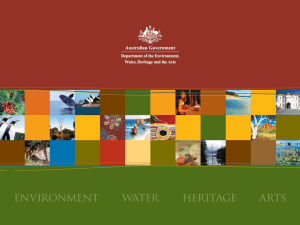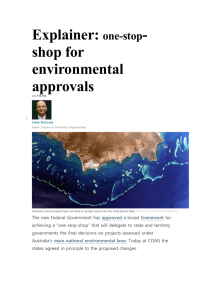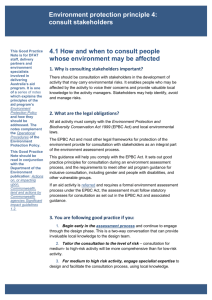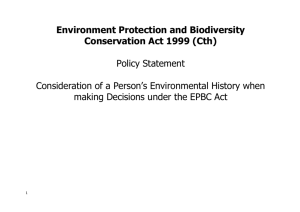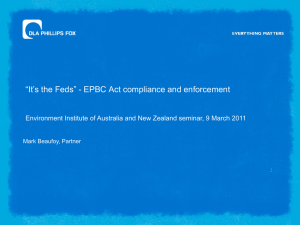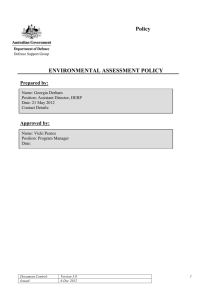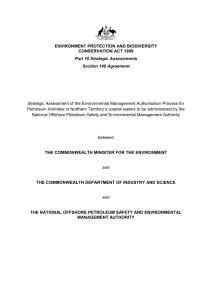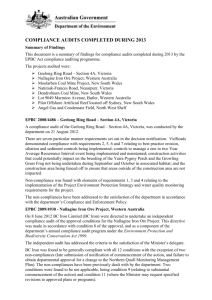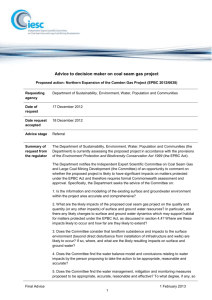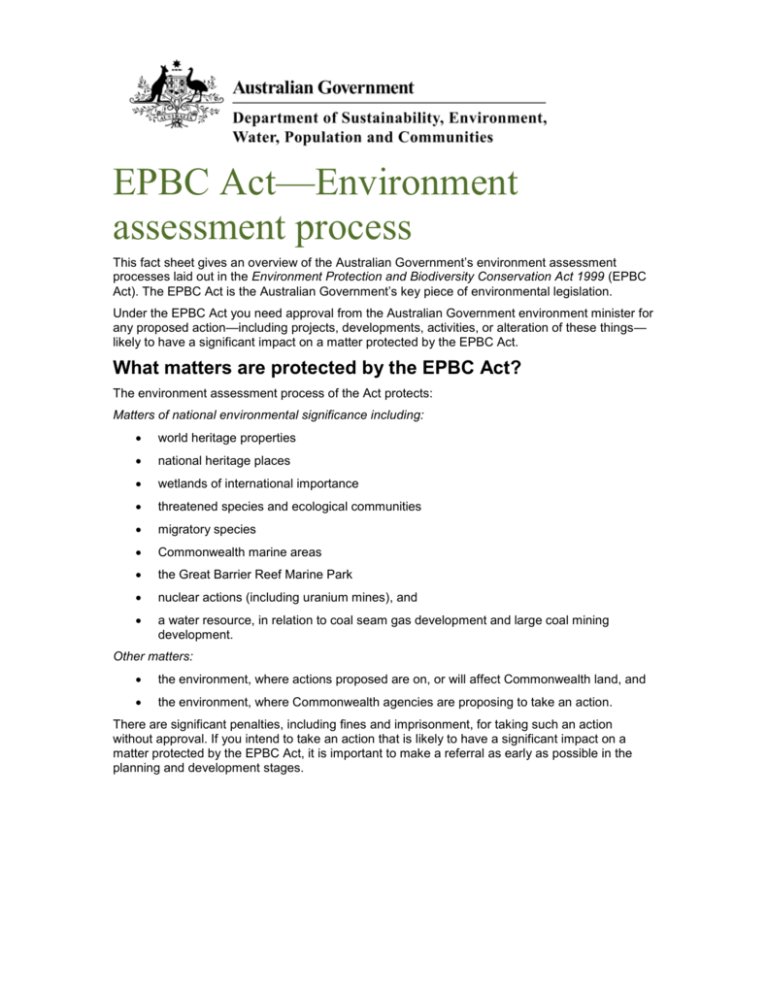
EPBC Act—Environment
assessment process
This fact sheet gives an overview of the Australian Government’s environment assessment
processes laid out in the Environment Protection and Biodiversity Conservation Act 1999 (EPBC
Act). The EPBC Act is the Australian Government’s key piece of environmental legislation.
Under the EPBC Act you need approval from the Australian Government environment minister for
any proposed action—including projects, developments, activities, or alteration of these things—
likely to have a significant impact on a matter protected by the EPBC Act.
What matters are protected by the EPBC Act?
The environment assessment process of the Act protects:
Matters of national environmental significance including:
world heritage properties
national heritage places
wetlands of international importance
threatened species and ecological communities
migratory species
Commonwealth marine areas
the Great Barrier Reef Marine Park
nuclear actions (including uranium mines), and
a water resource, in relation to coal seam gas development and large coal mining
development.
Other matters:
the environment, where actions proposed are on, or will affect Commonwealth land, and
the environment, where Commonwealth agencies are proposing to take an action.
There are significant penalties, including fines and imprisonment, for taking such an action
without approval. If you intend to take an action that is likely to have a significant impact on a
matter protected by the EPBC Act, it is important to make a referral as early as possible in the
planning and development stages.
Environment assessment processes
There are two key stages in the environment assessment process required by the EPBC Act:
Referral: How do I know if my proposed action requires approval under the EPBC Act?
Assessment/decision whether to approve: How will the minister consider my action? How
is a decision made?
1. Referral
The purpose of the referral stage is to determine whether or not a proposed action requires
approval under the EPBC Act.
Step 1: Submitting a referral. Before taking an action that could have a significant impact on a
matter protected by the EPBC Act, you must complete a referral form (available at
www.environment.gov.au/epbc/assessments/referral-form.html) and submit it to the minister via
the department for consideration.
Step 2: The decision process. Following the receipt of a valid referral, the minister has
20 business days to decide whether the proposed action will require assessment and approval
under the EPBC Act.
Step 3: Public comment period. As part of the total 20 business days taken for the referral
process, there is a 10 business day public comment period. This provides an opportunity for
relevant Australian, state and territory government ministers and members of the public to
comment on the proposed action.
Step 4: The decision whether an action requires assessment and approval. Within the
20-business day timeframe, the minister will decide whether a proposed action is likely to have a
significant impact on one or more matters protected by the EPBC Act. If a significant impact is
likely the action will need to be assessed and approved under the EPBC Act before it can
proceed. This is called a ‘controlled action’.
Step 5: How will the proposed action be assessed? Proposed actions can be assessed using
different methods, depending on a range of considerations, including the complexity of the
proposed action. The minister will let you know which method will be used in assessing your
proposed action.
Helpful hint: Providing appropriate documentation
Not every action that involves a matter protected by the EPBC Act will have a significant impact,
so it is important that you provide all available information about the proposed action, as well as
measures you will be putting in place to reduce adverse impacts on those matters.
2. Assessment/decision whether to approve
Actions can be assessed using one of the following assessment methods:
accredited assessment
assessment on referral information (assessment done solely on the information provided
in the referral form)
assessment on preliminary documentation (referral form and any other relevant material
identified by the minister as being necessary to adequately assess a proposed action)
assessment by environmental impact statement (EIS) or public environment report
(PER), and
assessment by public inquiry.
The EPBC Act sets out the process and timing requirements for each type of assessment. This is
summarised in the EPBC Act Environment Assessment Process flowchart on next page.
Reducing duplication of Australian and state/territory government processes
The Australian Government has bilateral agreements with all state and territory governments to
accredit environment assessment processes that meet set standards.
If you need EPBC Act approval, in addition to state or territory government approval, it may be
possible to do a single assessment, avoiding duplication. To take advantage of this opportunity it
is important that you make a referral to the minister early in the development of your proposal.
Helpful hint:
Taking measures to avoid significant impacts
In some cases, approval may not be required because you are proposing to put in place
measures to avoid impacts on a matter protected by the EPBC Act. For example, you may
commit to carrying out your construction activities at a time that will avoid the breeding season of
migratory birds, thereby avoiding significant disturbances to a protected species. In these cases,
you may be able to proceed without further assessment and approval under the EPBC Act, on the
condition that you carry out your proposed action in the manner prescribed (not controlled action
‘particular manner’).
Frequently asked questions
What will the minister consider when deciding if a proposed action should be
approved?
When deciding if a proposed action should be approved, and what conditions to impose, the
minister will consider the impacts of the proposed action on matters protected by the EPBC Act
and other economic and social matters. The minister must take into account:
the principles of ecologically sustainable development
the results of the assessment of the impacts of the proposed action, including the
relevant recommendation report from the secretary of the federal environment
department
referral documentation
community and stakeholder comments
any other relevant information available on the impacts of the proposed action, and
relevant comments from other Australian Government and state and territory government
ministers (such as information on social and economic factors).
The minister may also take into account the environmental history of the individual or company
proposing to take the action, including the environmental history of the executive officers of
companies, and parent companies and their executive officers.
What decisions can the minister make?
Following the assessment of your proposed action, the minister will decide whether to:
approve your action
approve your action subject to constraints (that is, place conditions on the action), or
not approve your action.
Can I be asked to provide more information?
You can be asked to provide further information so that an informed decision can be made.
The timeframe for making the next relevant decision in the assessment process stops until this
information is received.
What conditions can be placed on an approval?
The minister may attach conditions to an approval to protect, repair or mitigate damage to a
matter protected by the EPBC Act. Conditions can include bonds or other securities, independent
environmental auditing and compliance monitoring.
The minister will provide you with a copy of the proposed decision on whether or not to approve
an action, and the proposed conditions (if any) to attach to the approval, for comment before
making a final decision.
How will I be notified of the minister’s decision?
Once the minister has made a final decision you will receive a copy of the approval including
conditions attached to the approval (if any), or notice of the refusal. Decisions are published on
the Government Notices Gazette and on the department’s web site.
Other permits
What about state, territory and local government environmental authorisations?
Getting approval under the EPBC Act does not remove the need to seek relevant state and
territory and local government authorisations. To reduce delays and provide the opportunity to
coordinate assessments, you should consider making an EPBC Act referral no later than when
you begin state or territory authorisation processes.
Will I need other Australian Government permits?
If a proposed action is to take place on Commonwealth land or in the Commonwealth marine
area, there may be cases where, even though the action is not considered to be significant and
does not require approval through the referral process, it may still require a permit under a
different section of the EPBC Act.
Separate permits may be required for any actions affecting an individual member of a threatened,
marine or migratory species, or a whale or dolphin. If you require a permit, then you should
submit a permit application at the same time as submitting a referral. The EPBC Act also
regulates activities in Commonwealth protected areas and reserves, or which involve the import
and export of wildlife.
If your action is in the Great Barrier Reef Marine Park, you may also require permission under the
Great Barrier Reef Marine Park Act 1975. A permission under that Act may be required even if
significant impact on the environment of the Great Barrier Reef Marine park is not likely. For more
information, go to www.gbrmpa.gov.au
Further information about the EPBC Act is available from the department’s website at
www.environment.gov.au/epbc, by emailing ciu@environment.gov.au, or calling 1800 803 772.
Referral forms are also available from the department’s website at:
www.environment.gov.au/epbc/assessments/referral-form.html
The Significant impact guidelines 1.1 provides guidance on whether an action is likely to have a
significant impact on a matter protected by the EPBC Act. It is available at:
www.environment.gov.au/epbc/publications/nes-guidelines.html
The Significant impact guidelines 1.2 provides guidance in relation to actions on, or impacting
upon, Commonwealth land, and actions by Commonwealth agencies. It is available at
www.environment.gov.au/epbc/commonwealth-guidelines.html
For assistance with a referral, email: epbc.referrals@environment.gov.au
Disclaimer
The views and opinions contained in this document are not necessarily those of the Australian Government. The contents of this document
have been compiled using a range of source materials and while reasonable care has been taken in its compilation, the Australian
Government does not accept responsibility for the accuracy or completeness of the contents of this document and shall not be liable for any
loss or damage that may be occasioned directly or indirectly through the use of or reliance on the contents of the document.
© Commonwealth of Australia 2013
This work is copyright. You may download, display, print and reproduce this material in unaltered form only (retaining this notice) for your
personal, non-commercial use or use within your organisation. Apart from any use as permitted under the Copyright Act 1968, all other
rights are reserved. Requests and inquiries concerning reproduction and rights should be addressed to Commonwealth Copyright
Administration, Attorney General’s Department, Robert Garran Offices, National Circuit, Barton ACT 2600 or posted at www.ag.gov.au/cca.

